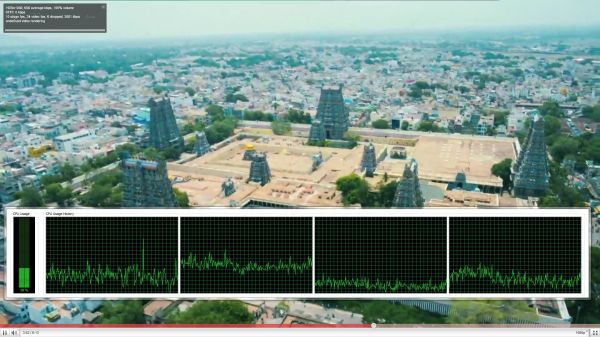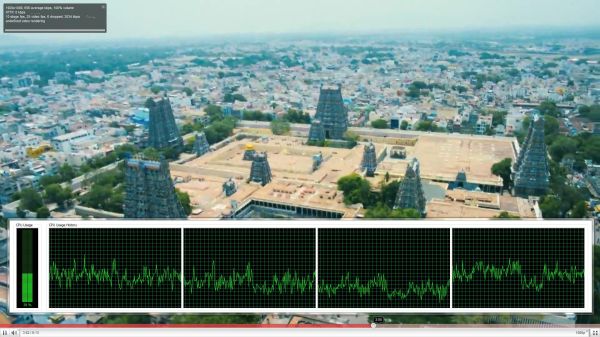Dell Zino HD 410 HTPC Review
by Ganesh T S on February 19, 2011 7:08 AM EST- Posted in
- HTPC
- Dell
- AMD
- Media Streamer
- ATI
The Zino 410 is covered quite nicely with respect to networking hardware. With support for both Gigabit Ethernet and 802.11n, it really doesn't matter if you keep the unit beyond cable reach from the router. All our network streaming tests were carried out with a 300 Mbps 802.11n network (currently provided in my lab location by a RT-N16 802.11n gigabit router from Asus). We were easily able to stream HD clips of more than 50 Mbps. HD YouTube videos and HD Netflix streaming had no issues.
While on the topic of network streaming, let us take a brief look at how the system performs while accessing online video services. We used Flash 10.1 in Firefox 3.6 with ATI Catalyst 11.1 for testing.
The first set of screenshots below show the CPU usage while playing back a 1080p YouTube video with and without hardware acceleration enabled. This is the same clip as the one used in the Core 100 and Vision 3D reviews. As can be seen, the GPU indeed supports Flash acceleration. However, the difference between the hardware accelerated and non-hardware accelerated CPU usage is around 11% only (39% for no hardware acceleration and 28% for hardware acceleration). We expect similar results for videos on Hulu.
1080p YouTube HD Streaming without Hardware Acceleration

1080p YouTube HD Streaming with Hardware Acceleration
Netflix streaming, on the other hand, uses Microsoft's Silverlight technology. Unlike Flash, hardware acceleration for the video decode process is not controlled by the user. It is upto the server side code to attempt GPU acceleration. Thankfully, Netflix does try to take advantage of the GPU's capabilities. This is evident from the A/V stats recorded while streaming a Netflix HD video at the maximum possible bitrate of 3.8 Mbps. While the video is definitely not 1080p, we observe that the CPU utilization of around 40% is higher than the CPU usage for a 1080p YouTube video.

Netflix HD Streaming with Hardware Acceleration
We suspect that the handling of the DRM in the case of Netflix streaming is done by the CPU, resulting in the higher usage.
Users of media streamers streaming online videos often have to put up with messages of the sort 'This content is not available on TV connected devices' or need to queue up the videos on a PC before accessing them through their media streamer box. HTPC users don't need to worry about any such limitations. For online media consumption, the Zino 410 is as good as the Core 100, but not as efficient as the Vision 3D.











69 Comments
View All Comments
aylafan - Monday, February 21, 2011 - link
Wouldn't the motherboard have to be grounded to the case? I don't think many manufactuers has designed the motherboard to be hanging in the middle of the case. If you flipped the motherboard upside down; it would be practically the same thing, but less efficient. Now, you can put the motherboard on the side of the case, but then it would be a normal size desktop PC and wouldn't be a HTPC anymore. I'm just visualizing this in my head. I could be wrong. Futhermore, they would need to redesign the heatsink with less space they have to work with. We're talking about a compact HTPC here and not one of those no cover, Antec custom cases.Also, I don't see the point of having a hard drive underneath the motherboard because the motherboard would practically cut the HTPC in half; trapping all the heat coming from the hard drive on the bottom half of the HTPC. They could reengineere the entire thermal design, but this would mean starting from scratch again. Like adding a bottom fan to pull out hot air and making holes on the sides of the cases, etc. There are just too many variables to this.
Just my opinion. Don't take it too seriously.
cjs150 - Tuesday, February 22, 2011 - link
The reason I ask is that I have a Morena case that works as I have described.Now the Morena case has a number of flaws (cheap plastic being the least of the problems) which with a bit of "apple" design could be seriously improved but it runs 24/7 as my atom server without any problems and you can feel the convection working.
Neither HD or optical drive get that hot - at least not compared to the CPU!
It is not as though you need to cut the case in half because the height of a slim line optical and a 2.5" HD is something like 15mm max - it also allows for better cable management.
It is just I have this nagging feeling that the designs are based on "this is how we have always done it" rather than looking at it logically - or maybe because the designers expected all cases to be placed vertically rather than horizontally
Maybe it is also because I am looking to build an HTPC and keep wanting to put a slow running fan in the top to keep memory and CPU cool - with a case that is barely 100 mm tall
strikeback03 - Tuesday, February 22, 2011 - link
Technically you could build something mostly like this with off the shelf components, though it might well be more expensive.http://www.logicsupply.com/products/nf98_lf
ganeshts - Tuesday, February 22, 2011 - link
The mobile processors are not cheap at all, and trying to find them on sale at Newegg or one of the top e-tailers is a tall task..vol7ron - Tuesday, February 22, 2011 - link
$775 for this? I don't see what HTPCs are more expensive than laptops and desktops.lenkiatleong - Monday, March 7, 2011 - link
Hi Ganesh,1) Thanks for your excellent review on this Dino and ASRock Vision.
2) The points that i missed from your review are:
a) Using BluRay disc, are they able to stream Dolby TrueHD or DTS HD Master codec from HTPC (Dell/ASRock) to your Onkyo TX-SR606 via HDMI? You should be able to see the codec being display on your Onkyo set.
b) Are they able to stream blu ray and dvd iso files from NAS or HDD?
Regards
Len
ganeshts - Sunday, May 15, 2011 - link
Sorry for the late reply, but the answers to your questions are:1. Yes, but don't expect the bundled PDVD to play nice with your requirements. You are better off investing in a full featured BR software player than what Dell bundles. Otherwise, make a backup of your BR with MakeMKV and play with open source players. Bitstreaming works fully well.
2. Yes, it can easily stream from NAS or external HDDs provided you have the appropriate software players. [ PowerDVD / TMT / WinDVD ]
alexn - Thursday, June 30, 2011 - link
I purchased this unit in January 2011,received in February. For two months I was fighting on my own with:1.Dropping WiFi signal 5 feet away from 802.11 N router;
2.Extremely poor HDMI video.
Then I decided take it to Dell tech support. After many hours wasted on phone they decided to replace motherboard, sent tech to my house, who replaced motherboard and sent back my motherboard with external video card. Neither the person who sent m/b for replacement, nor tech himself did not know, that there is external video card, which went away. No surprises, there was no video after this 'repair". They sent another tech with another m/b, replaced it... no video. Only the third tech with the third m/b asked me, where is you video card??? Afetr long fighting they sent me refurbished system, which is working, but the HDMI output is as awful, as it was, so I connected it via VGA output and sound cable and it works.
By the way, wireless card replacement fixed connectivity problem.
So my moral: Dell's service in India and techs in the USA usually don't know anything, HDMI output in this system is really bad.
myangeldust - Tuesday, January 24, 2012 - link
I used this as a home theater PC and it works great. It records four shows simultaneously via a couple of HDHomeRun external dual tuners. I can even watch a TV show as this is happening with no issues. And thanks to gigabit networking I can listen to music streamed from a media server. It includes PowerDVD integrated with Windows Media Center to play Blu-rays and [upscaled] DVDs.Changing the optical drive from a nonmotorized tray model to a slot-load model. The current tray only extends part way and requires a bit more effort to load/unload than a user would expect. One can easily move the HTPC while doing this and even damage the tray.